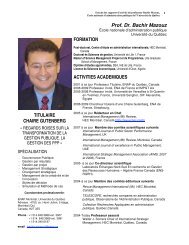Why do firms both make and buy? An investigation of concurrent ...
Why do firms both make and buy? An investigation of concurrent ...
Why do firms both make and buy? An investigation of concurrent ...
Create successful ePaper yourself
Turn your PDF publications into a flip-book with our unique Google optimized e-Paper software.
298 A. Parmigiani<br />
power <strong>of</strong> the ordered <strong>and</strong> multinomial logit models,<br />
we can infer whether <strong>concurrent</strong> sourcing can<br />
better be depicted as a point along a <strong>make</strong>/<strong>buy</strong><br />
continuum or as a separate <strong>and</strong> distinct alternative.<br />
Since multiple items were used for the variables,<br />
exploratory factor analysis (EFA) <strong>and</strong> then confirmatory<br />
factor analysis (CFA) were employed to<br />
investigate the relationships between the items <strong>and</strong><br />
the variables (<strong>An</strong>derson <strong>and</strong> Gerbing, 1988). The<br />
EFA results indicated that the each <strong>of</strong> the variables<br />
were unidimensional <strong>and</strong> distinct. CFA submodels<br />
for each individual variable were created <strong>and</strong><br />
then aggregated into a final, full model. All <strong>of</strong> the<br />
CFA models were estimated using full information<br />
maximum likelihood <strong>and</strong> were evaluated using six<br />
different indices (Hu <strong>and</strong> Bentler, 1998). The final<br />
model sufficiently fit the data (χ 2 = 1521.642, 421<br />
degrees <strong>of</strong> free<strong>do</strong>m, p





